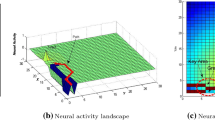Abstract
As neuroscience gradually uncovers how the brain represents and computes with high-level spatial information, the endeavor of constructing biologically-inspired robot controllers using these spatial representations has become viable. Grid cells are particularly interesting in this regard, as they are thought to provide a general coordinate system of space. Artificial neural network models of grid cells show the ability to perform path integration, but important for a robot is also the ability to calculate the direction from the current location, as indicated by the path integrator, to a remembered goal. This paper presents a neural system that integrates networks of path integrating grid cells with a grid cell decoding mechanism. The decoding mechanism detects differences between multi-scale grid cell representations of the present location and the goal, in order to calculate a goal-direction signal for the robot. The model successfully guides a simulated agent to its goal, showing promise for implementing the system on a real robot in the future.

















Similar content being viewed by others
References
Burak Y, Fiete IR (2009) Accurate path integration in continuous attractor network models of grid cells. PLoS Comput Biol 5(2):e1000291
Bush D, Barry C, Manson D, Burgess N (2015) Using grid cells for navigation. Neuron 87(3):507–520
Chadwick MJ, Jolly AE, Amos DP, Hassabis D, Spiers HJ (2015) A goal direction signal in the human entorhinal/subicular region. Curr Biol 25(1):87–92
Edvardsen V (2015) A passive mechanism for goal-directed navigation using grid cells. In: Proceedings of the European conference on artificial life, pp 191–198
Erdem UM, Milford MJ, Hasselmo ME (2015) A hierarchical model of goal directed navigation selects trajectories in a visual environment. Neurobiol learn Mem 117:109–121
Erdem UM, Hasselmo M (2012) A goal-directed spatial navigation model using forward trajectory planning based on grid cells. Eur J Neurosci 35(6):916–931
Erdem UM, Hasselmo ME (2014) A biologically inspired hierarchical goal directed navigation model. J Physiol Paris 108(1):28–37
Fiete IR, Burak Y, Brookings T (2008) What grid cells convey about rat location. J Neurosci 28(27):6858–6871
Giocomo LM, Moser MB, Moser EI (2011) Computational models of grid cells. Neuron 71(4):589–603
Giovannangeli C, Gaussier P (2008) Autonomous vision-based navigation: goal-oriented action planning by transient states prediction, cognitive map building, and sensory-motor learning. In: 2008 IEEE/RSJ international conference on intelligent robots and systems, pp 676–683
Hafting T, Fyhn M, Molden S, Moser MB, Moser EI (2005) Microstructure of a spatial map in the entorhinal cortex. Nature 436(7052):801–806
Huhn Z, Somogyvári Z, Kiss T, Érdi P (2009a) Distance coding strategies based on the entorhinal grid cell system. Neural Networks 22(5):536–543
Huhn Z, Somogyvári Z, Kiss T, Érdi P (2009b) Extraction of distance information from the activity of entorhinal grid cells: a model study. In: 2009 International joint conference on neural networks, pp 1298–1303
Kubie Jl, Fenton AA (2012) Linear look-ahead in conjunctive cells: an entorhinal mechanism for vector-based navigation. Front Neural Circuits 6:20
Masson C, Girard B (2011) Decoding the grid cells for metric navigation using the residue numeral system. In: Advances in Cognitive Neurodynamics (II), Springer, pp 459–464
McNaughton BL, Battaglia FP, Jensen O, Moser EI, Moser MB (2006) Path integration and the neural basis of the ‘cognitive map’. Nat Rev Neurosci 7(8):663–678
Milford M, Schulz R (2014) Principles of goal-directed spatial robot navigation in biomimetic models. Philos Trans Royal Soc B: Biol Sci 369(1655):20130484
Milford M, Wyeth G (2010) Persistent navigation and mapping using a biologically inspired SLAM system. Int J Robot Res 29(9):1131–1153
O’Keefe J, Dostrovsky J (1971) The hippocampus as a spatial map. Preliminary evidence from unit activity in the freely-moving rat. Brain Res 34(1):171–175
Solstad T, Boccara CN, Kropff E, Moser MB, Moser EI (2008) Representation of geometric borders in the entorhinal cortex. Science 322(5909):1865–1868
Spiers HJ, Barry C (2015) Neural systems supporting navigation. Curr Opin Behav Sci 1:47–55
Sreenivasan S, Fiete I (2011) Grid cells generate an analog error-correcting code for singularly precise neural computation. Nat Neurosci 14(10):1330–1337
Stemmler M, Mathis A, Herz AV (2015) Decoding the population activity of grid cells for spatial localization and goal-directed navigation. bioRxiv 021204
Stensola H, Stensola T, Solstad T, Frøland K, Moser MB, Moser EI (2012) The entorhinal grid map is discretized. Nature 492(7427):72–78
Sun H, Yao Tr (1994) A neural-like network approach to residue-to-decimal conversion. In: Neural Networks, 1994. IEEE World Congress on Computational Intelligence., 1994 IEEE international conference on, IEEE, vol 6, pp 3883–3887
Taube JS, Muller RU, Ranck JB (1990) Head-direction cells recorded from the postsubiculum in freely moving rats. i. description and quantitative analysis. J Neurosci 10(2):420–435
Wei XX, Prentice J, Balasubramanian V (2015) A principle of economy predicts the functional architecture of grid cells. ELife 4:e08362
Acknowledgments
The author is grateful to Keith Downing and Trygve Solstad for helpful discussions, feedback and advice.
Author information
Authors and Affiliations
Corresponding author
Rights and permissions
About this article
Cite this article
Edvardsen, V. Goal-directed navigation based on path integration and decoding of grid cells in an artificial neural network. Nat Comput 18, 13–27 (2019). https://doi.org/10.1007/s11047-016-9575-0
Published:
Issue Date:
DOI: https://doi.org/10.1007/s11047-016-9575-0




